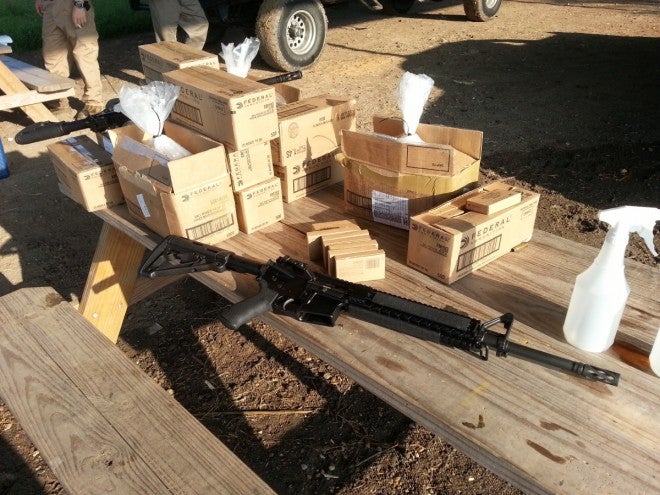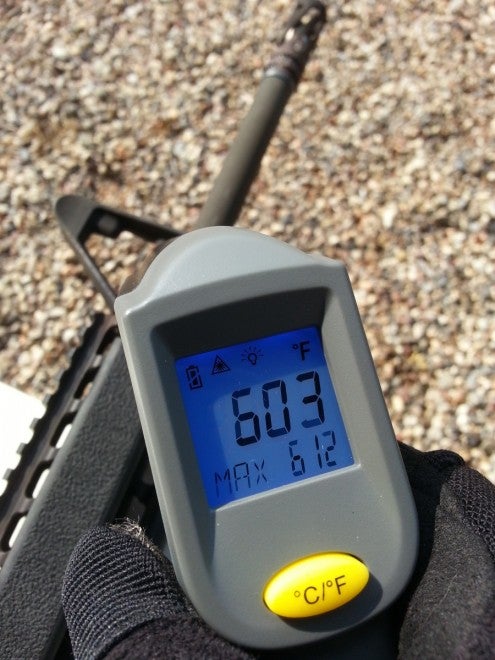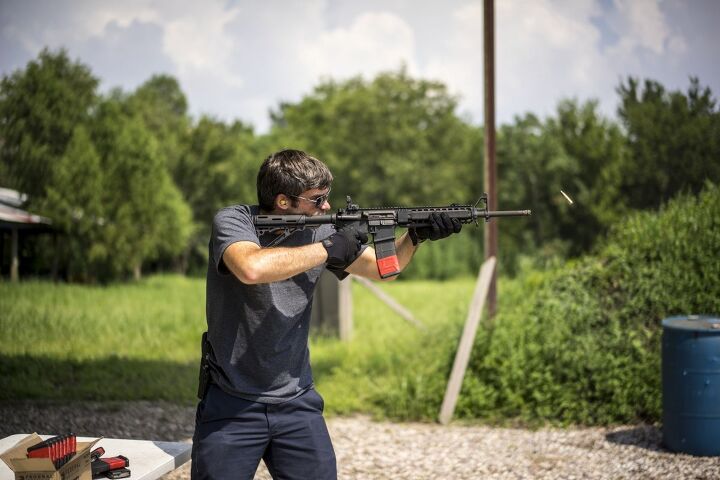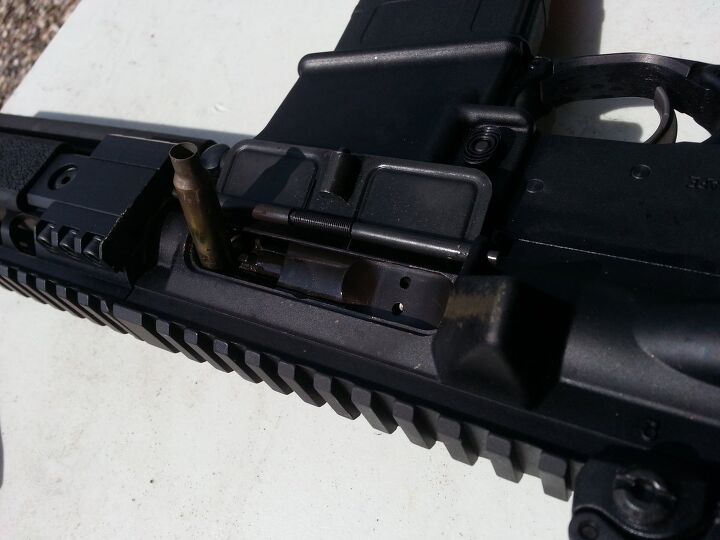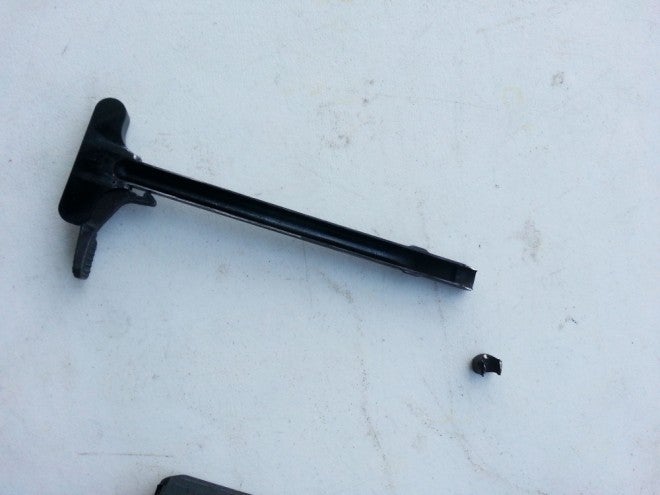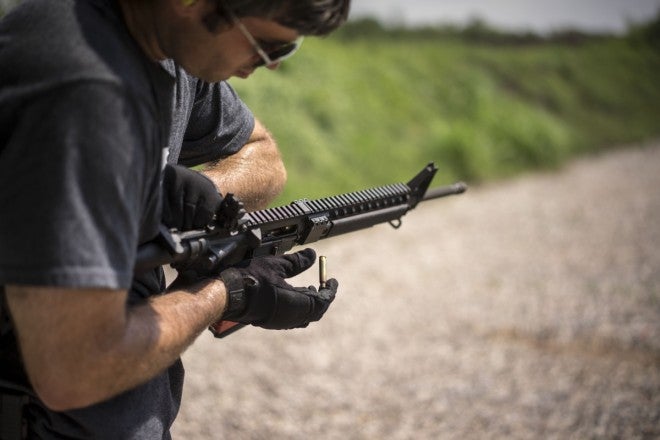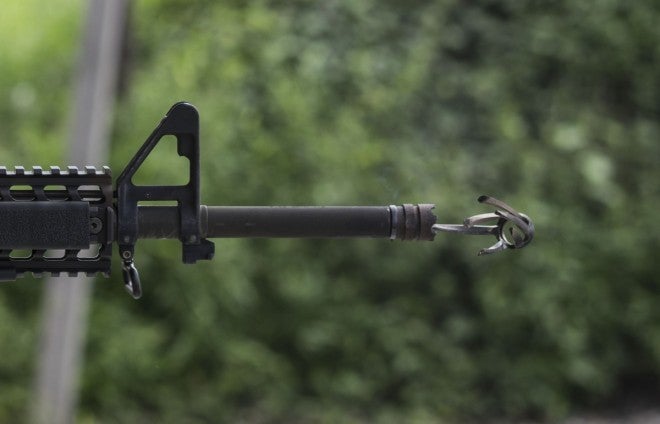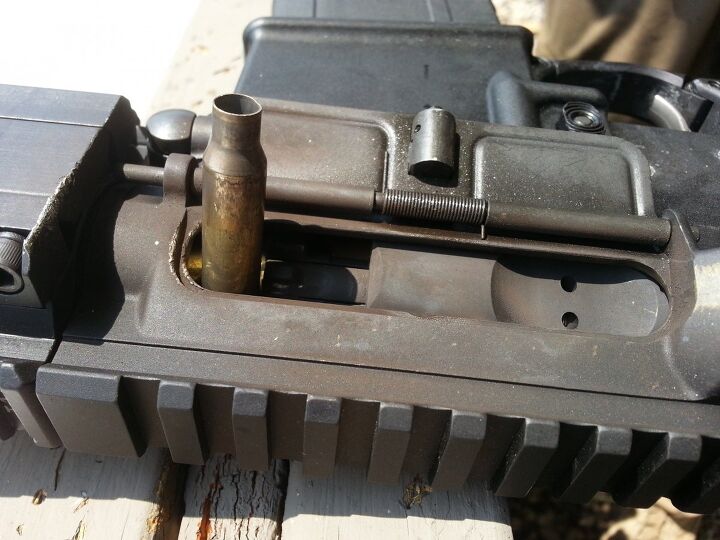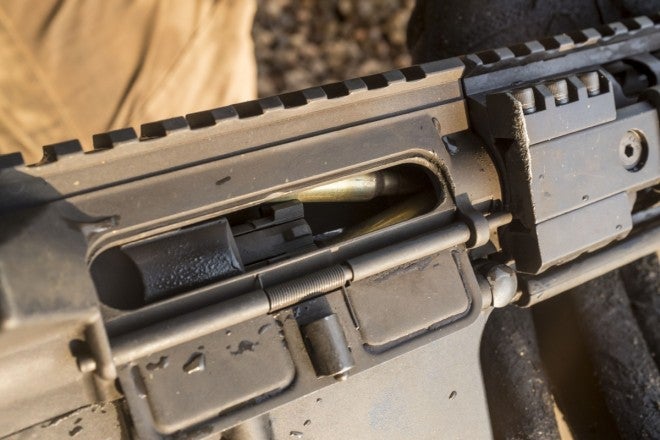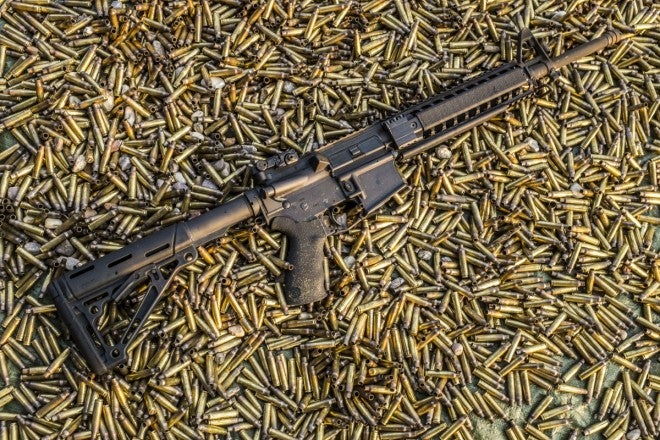Earlier this month, I took part in firing ten thousand rounds through an AR-15 in one day. Here’s why: At the 2013 NRA Annual Meetings in Houston, Texas, I came across a number of new products and companies, but none stood out as much as Battle Rifle Company. Looking back, in fact, I remember few products other than those at the BRC booth.
If you’re not familiar with the saga of previous articles regarding Battle Rifle Company, you might expect me to start waxing philosophically about the high quality fit and finish of their products, or their relentless dedication to customer service, and so on. On the contrary, their booth stood out because I was quite frankly horrified by what I saw. I wrote not one, but two articles about them, titled “What Makes a Bad AR?” and “Pretty Much the Worst AR-15s I’ve Ever Seen.”
Needless to say, there were strong reactions to these articles, and the company took a lot of flak over the following weeks as they were shared on other sites. Both articles rank extremely well on various engines for any web search regarding the company. In other words, a prospective buyer has a significant chance of coming across these articles a year and a half later.
If the company simply ignored the articles and kept making the same products, this would be all well and good – an educated consumer could make the right decision for their needs based on available information. However, if the company had changed their products as a result of what was written, then I would be doing them a disservice by not following up on those original articles.
I read TFB writer Alex C’s article on Battle Rifle Company in May of this year and wondered where the company was heading. Overall I was not particularly impressed with what I saw in that article. It did not really address the concerns laid out in the previous articles, and it did not consist of significant or meaningful testing.
So when I was contacted by Battle Rifle Company’s PR representative, who asked me to see what changes had been made and offered me a chance to test the rifle “like never before,” I was intrigued. I felt that I had a moral obligation to revisit the company, and I wondered if the other follow up article was accurate.
I suggested to BRC that if they wanted to make an impression on the AR world and prove that their products were up to snuff that they should put on a test of one or two rifles and a significant amount of ammunition. They agreed.
Battle Rifle Company built two identical ARs with the intention of letting me pick one for the test, just so I’d know I wasn’t getting a ringer. Ideally it would have been one of a hundred, but I wasn’t getting any dishonest vibes here, and quickly selected one of the two.
The rifle was a midlength gas system AR15, or BR4 as BRC refers to their carbines and rifles. This specific model was the Midlength BR4 Spartan. It featured an Ergo quad rail, a Green Mountain 1/8 twist barrel, a nickel boron plated fire control group, the BRC Disintegrator muzzle device, and a Hogue stock, among other things. The bolt carrier group was M16 profile and the bolt was made from 9310 steel instead of the standard Carpenter 158. 9310 offers moderate improvements from a metallurgical standpoint, while C158 is considered the standard quality bolt steel. Bolt carriers are made from 8620 tool steel, and some low budget manufacturers also make the bolt from that material. It is insufficient for anything but display use with regard to the bolt.
The barrel was made from 41V50 steel, which is good quality steel. It has a 5.56 chamber which is chrome lined as is the bore. After receiving the barrels from Green Mountain, Battle Rifle Company sends them to 300 Below, Inc for cryogenic treatment, which, according to 300 Below, increases barrel life and decreases group size by 50%.
Texas
I flew to Houston several weeks ago to see the BRC facility and participate in the shooting. In the interests of full disclosure, my expenses (gas, lodging, etc) were covered by Battle Rifle Company and a week after I returned home I received the test rifle via my local FFL friend.
Chris Kurzadkowsi, owner of Battle Rifle Company, picked me up at the airport on Sunday evening; after discovering that Texas allows smoking in bars, I had a restful night’s sleep in my hotel room and availed myself of the free continental breakfast. I had a long day of trigger pulling ahead of me and needed all the nutrition I could get. Again, Chris picked me up. We headed to the range, the backseat of his truck loaded to the gills with rifles and ammunition, and our minds full of anticipation. Or dread, one of the two. I’ve fired thousands of rounds in a day before, and it’s not as fun as it sounds.
We had agreed upon some basic rules for the testing, all of which were proposed by Chris – the barrel would not get hotter than 700 degrees as measured by an infrared thermometer, we would stop to clean the rifle every two thousand rounds and lubricate every thousand, that accuracy would be tested before and after firing was completed, and that we’d fire ten magazines at a time and then allow the rifle to cool a little bit. Lubrication was with FrogLube, their choice of lubricant.
As it turned out, we had to modify things a little bit as the testing continued. But I’ll describe that later.
I started shooting about one round per second, and just kept shooting. Chris’s son and Josh, the PR representative, spent most of the day loading magazines. I shot, and shot, and shot, and shot some more.
From the very first round, I noticed that ejection was weak and that the cases either went nearly straight forward or nearly straight backward. We encountered the first malfunction at about 800 rounds, a stuck case, followed rather quickly by a failure to eject in the classic “stovepipe” fashion.
I cleared the malfunctions and kept shooting. About a hundred rounds later, we encountered another problem – a broken charging handle. I haven’t seen a whole lot of broken charging handles, and especially not after 900 rounds and hardly any manipulation of the charging handle (almost all reloads used the bolt catch). The break was at the forward most portion of the charging handle, where it fits over the gas key on the bolt carrier.
Another, nearly identical break in the charging handle was encountered after approximately 1200 rounds, along with a handful of malfunctions similar to the first failure to eject. The charging handles broke due to the fact that they were improperly machined by a supplier and thus dimensionally incorrect.
Another problem we encountered was that the muzzle device quickly began to fracture and by 1200 rounds eventually separated from the rifle; the “tines” of the device were quite small in comparison to other devices on the market, resulting in premature failure. The “Disintegrator” name was unintentionally ironic.
And then, rather suddenly, we started encountering dozens of malfunctions, almost all of them failures to eject. The forward edge of the ejection port, as well as the right side of the quad rail, were becoming battered by spent cases. Eventually I asked what the gas port diameter was, and BRC’s gunsmith told me it was .082″. Given that the weapon was equipped with a carbine buffer and was firing 5.56 pressure ammunition, .082″ is far too large, and the primary reason for the malfunctions. Even leaving out the type of ammunition and the buffer weight, I would not purchase a 16″ midlength AR-15 with a .082″ gas port. Gas ports, however, are not easily remedied at the range.
I noticed that BRC had brought one of their .308 caliber ARs, and took it apart to see what buffer was inside. It had a stainless steel “shorty” buffer common to 308 ARs using AR-15 carbine length tubes. This is certainly not ideal for a 5.56 AR using the same tube, for the 308 bolt carrier is longer and requires a shorter buffer to achieve full travel – in other words, a 5.56 AR using the short buffer will have potentially excessive travel – but still, it was better than the carbine buffer from a weight standpoint.
The added weight of the steel buffer reduced malfunctions, but did not eliminate them; by the end of ten thousand rounds, I had experienced and/or observed 69 malfunctions, although other shooters might have cleared other malfunctions and continued shooting without my knowledge. Many of the last malfunctions were failures to eject with the spent case coming to rest above the bolt carrier; this is one of the most difficult to clear malfunctions one might encounter with an AR, although once learned, the technique is rather simple.
Accuracy
Accuracy and precision testing on the day of the test was performed by BRC’s gunsmith using a 16x scope at 25 yards. With XM193, the initial ten shot group was roughly an inch and a quarter at 25; at the end of the day, he fired another ten shot group which was approximately five inches at 25. I surmised that accuracy would improve if the bore was not fouled with ten thousand rounds worth of copper.
Before shipping the cleaned test rifle to me, BRC fired a ten shot group using their 77gr BTHP (they call it 77gr FMJ) reloaded ammunition at 100 yards. I was not present for the firing of this group, which appears to be nearly identical in size to a group I fired with the same ammunition at 25 yards, and significantly smaller than the ten shot group I fired at 100 yards. I cannot account for the discrepancy.
On a related note, Chris told me about a Marine sniper who had a problem with his issued rifle. None of the Marine armorers could fix it, so he was given permission by his commanding officer to buy a commercial rifle. The Marine bought a BR4 and was allowed to deploy with it. Chris told me that the sniper made “twenty or thirty kills” with the rifle.
Summary
I could tell that the entire BRC crew was disheartened by the results as testing went on. They had done a lot of hard work to improve their products, they had made great strides, they had invited me out to see how much they had improved… Despite taking a giant slap to the face on the internet, they admitted that they needed to change direction.
As objective as I was trying to be, part of me wanted the test to be a success – for the people who had put so much effort into putting the test on, and for me, so that I could feel better about having written the initial articles. If I write some tough words and a company responds by making their product better then everybody wins – alas, it was not to be.
They have definitely improved their products and the processes by which they make those products, but they are not yet as good as they want to be, or as good as they should be. The day after the test, I sat down with Chris and gave him some suggestions on QA/QC procedures as well as specific changes to be made to the rifles. I know he wanted to do well, but good intentions and good processes don’t necessarily go hand in hand.
I will be following up on this article with more technical information, including photos of the barrel after it is sectioned longitudinally.
To put this test in perspective, the last time I fired ten thousand rounds of Federal ammo through an AR-15, there were no malfunctions – not even one. The test rifles were off-the-shelf Bushmasters. True, that course of fire took place over multiple days, but once the rifle cools to ambient temperature (which takes less than half an hour), it does not know if the earth has rotated fully or not, and the BRC weapon was allowed to cool fully on multiple occasions. In my opinion, the tests are for the most part comparable. Even if they weren’t, by any objective standard, the Battle Rifle Company Midlength BR4 Spartan performed poorly.
UPDATE: Battle Rifle Company send us this response to Andrew’s article:
Statement from Battle Rifle Company
This was a great experience for us, and a chance to continue to learn and improve.
We thank Andrew for his observations and comments- we have also immediately responded to the suggestions and made even more improvements to our products and processes.
We had the opportunity to fire 10,000 rounds in a little over an 8 hour period. We had the opportunity to stress all the components of the rifle beyond where typical users would, and we took that knowledge and made changes in our materials used in manufacturing, in our suppliers and in our processes to make a better rifle. It is with great passion and determination that we produce the best products, and will work tirelessly to reach our goal. We want the consumer to know that we will stand behind every rifle we build.
Famous author Gary Ryan Blair once said, “Discipline is based on pride, on meticulous attention to details and on mutual respect and confidence. Discipline must be a habit so ingrained that it is stronger than the excitement of the goal or the fear of failure.”
We are a small company, competing in a huge AR market. Our roots in the military have taught us that discipline and attention to every detail is what will make us strong. This is the reason we reached out to Andrew and The Firearm Blog to do this 10,000 round test on an off-the-shelf rifle. To our knowledge, Battle Rifle Company one of the smallest AR manufacturers and Bushmaster, probably one of the largest AR manufacturers are the only two AR manufacturers to do such a test. We would like challenge others to follow suit.
We learned so much from Andrew’s testing, and we have already made needed adjustments. We have stepped up every effort on our internal team to insure the absolute best in quality control. We will not stop our testing and we will not stop improving our product, even if that means failing at times. We will never become the best unless every single possible problem is found, and some of these problems just couldn’t be found in 1,000 rounds.
Here are the actual adjustments we have made:
- We have addressed the over gassing directly with the barrel manufacturer and have made corrections
- Made corrections with the proper buffer and spring weights
- Redesign of our flash hider with new materials and thicker sidewalls
- The Charging handles were from a new batch which we returned to the manufacturer
- Shared our knowledge of the test with all our suppliers
We are making unheard-of strides to deliver the best product we can to our customers. We are thankful to Andrew and The Firearms Blog for assisting us in these efforts. Discipline and dedication makes us stronger and makes our product better. We will settle for nothing less.
Respectfully,
Battle Rifle Company
 Your Privacy Choices
Your Privacy Choices

